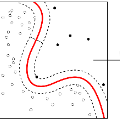We propose space-aware memory queues for in-painting and detecting anomalies from radiography images (abbreviated as SQUID). Radiography imaging protocols focus on particular body regions, therefore producing images of great similarity and yielding recurrent anatomical structures across patients. To exploit this structured information, our SQUID consists of a new Memory Queue and a novel in-painting block in the feature space. We show that SQUID can taxonomize the ingrained anatomical structures into recurrent patterns; and in the inference, SQUID can identify anomalies (unseen/modified patterns) in the image. SQUID surpasses the state of the art in unsupervised anomaly detection by over 5 points on two chest X-ray benchmark datasets. Additionally, we have created a new dataset (DigitAnatomy), which synthesizes the spatial correlation and consistent shape in chest anatomy. We hope DigitAnatomy can prompt the development, evaluation, and interpretability of anomaly detection methods, particularly for radiography imaging.
翻译:我们建议用有空间的记忆队列来绘制和探测射线图像中的异常现象(以 SQUID 缩放为缩放)。射线成像程序以特定身体区域为重点,从而产生非常相似的图像,并产生病人的经常性解剖结构。为了利用这种结构化信息,我们的SQUID由一个新的记忆队和特征空间中新的油漆块组成。我们显示,SQUID可以将射线解解剖结构分解成经常性模式;在推断中,SQUID可以识别图像中的异常现象(未见/修改的模式)。SQUID在两个胸前X射线基准数据集上超过5点的不受监视异常探测的艺术状态。此外,我们创造了一个新的数据集(DigitAnatomomy),该数据集综合了胸部解剖中的空间相关性和一致性形状。我们希望DigitAnatomy能够促进异常探测方法的开发、评估和可解释性,特别是用于放射成像。



